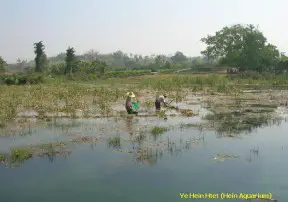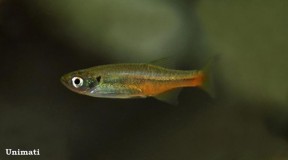Devario sondhii
Fireline Devario
SynonymsTop ↑
Danio sondhii Hora & Mukerji, 1934; Brachydanio sondhii (Hora & Mukerji, 1934)
Etymology
Devario: appears to be derived from a local vernacular name for the type species of the genus Cyprinus (now Devario) devario Hamilton, 1822.
sondhii:
Classification
Order: Cypriniformes Family: Cyprinidae
Distribution
Type locality is ‘Spring, about 15 3/4 miles east of Taunggyi and about 3 1/2 miles east of Hopong, southern Shan States, Myanmar’, and this may also be the type locality of Celestichthys margaritatus.
Additional occurrence details are lacking but some other species from the area have been recorded from waters associated with the Thanlwin (aka Salween) River throughout southern Shan.
Habitat
The habitat near Hopong is an area of permanently-flooded grassland formed by the damming of a spring for agricultural purposes and is around 1,040 metres AMSL.
The water is only around 30cm deep, transparent and supports dense growths of aquatic plants, mostly from the family Hydrocharitaceae which includes such genera as Elodea, Egeria and Blyxa.
Sympatric species include Celestichthys margaritatus, a Microrasbora very similar to M. rubescens, an undescribed Petruichthys sp. known to aquarists as the ‘rosy’ loach and Channa harcourtbutleri.
Maximum Standard Length
40 – 45 mm.
Aquarium SizeTop ↑
A tank with a base measuring 75 ∗ 30 cm or equivalent should be the minimum considered for this active species.
Maintenance
Best kept in a densely-planted tank and an excellent choice for the carefully-aquascaped set-up.
The addition of some floating plants to diffuse the light entering the tank also seems to be appreciated and adds a more natural feel.
Water movement does not need to be particularly strong as it mostly hails from sluggish waters though will also do well in a hill stream-type set-up provided torrent-like conditions are avoided.
Since it naturally occurs in pristine habitats it’s intolerant to accumulation of organic pollutants, requires more-or-less spotless water in order to thrive and should never be introduced to biologically immature aquaria.
Weekly water changes of 30-50% volume should be considered routine, and the tank must have a very tightly-fitting cover as it’s a particularly accomplished jumper and is prone to bouts of skittish behaviour.
Water Conditions
Temperature: 20 – 26 °C
pH: 6.5 – 7.5; a value of 7.3 was recorded at the locality described above.
Hardness: The water in northern Myanmar is typically soft so aim for somewhere within the range 18 – 90 ppm.
Diet
Insects and their larvae are likely to comprise the main constituents of the natural diet.
In the aquarium it’s a largely unfussy feeder and will accept most foods.
A good quality dried product can be used as the staple diet but this should be supplemented with regular meals of small live and frozen fare such as bloodworm, Daphnia, Artemia, etc., for the best colouration and conditioning.
Behaviour and CompatibilityTop ↑
This species is peaceful and can be maintained alongside other fishes that appreciate similar conditions such as other small cyprinids.
Bottom-dwellers could include loaches from genera such as Lepidocephalichthys or Nemacheilus plus catfishes such as Akysis, Hara or Erethistes spp.
Freshwater gobies like Rhinogobius or Stiphodon spp. and many freshwater shrimp should also work in well-oxygenated set-ups.
It’s a schooling species by nature and really should be kept in a group of at least 8-10 specimens.
Maintaining it in decent numbers will not only make the fish less nervous but result in a more effective, natural-looking display, while males will also display their best colours as they compete with one other for female attention.
Sexual Dimorphism
Sexually mature females should be rounder-bellied, less colourful and a little larger than males.
Reproduction
Like most small cyprinids Devario spp. are egg-scattering free spawners exhibiting no parental care.
When in good condition they will spawn often and in a well-planted, mature aquarium it’s possible that small numbers of fry may start to appear without intervention.
However if you want to maximise yield a more controlled approach is required.
The adult group can still be conditioned together but a smaller tank with a base measuring around 45cm x 30cm should also be set up and filled with mature water.
This should be very dimly lit and the base covered with some kind of mesh of a large enough grade so that the eggs can fall through but small enough so that the adults cannot reach them. The widely available plastic ‘grass’-type matting can also be used and works well, as does a layer of glass marbles.
Alternatively filling much of the tank with a fine-leaved plant such as Taxiphyllum spp. or wool mops can also return decent results.
The water itself should be of slightly acidic to neutral pH with a temperature towards the upper end of the range suggested above, and an air-powered sponge filter or air stone(s) should also be included to provide oxygenation and water movement.
When the adults are well-conditioned and the females appear gravid one or two pairs should then be introduced.
If ready spawning usually taking place within 24 hours, with the female tending to appear noticeably slimmer after the event, and after 48 hours the adults should be removed whether this is observed or not.
Incubation is temperature-dependant to an extent but typically lasts 24-36 hours with the young free-swimming a few days later.
Initial food should be Paramecium or similar, introducing Artemia nauplii, microworm, powdered dry foods, etc., once the fry are large enough to accept them.
NotesTop ↑
This species first appeared in the aquarium trade during the mid-2000s and there was some initial confusion surrounding its identity since it appears superficially similar to the sympatric Microrasbora cf. rubescens as well as the congener D. acuticephalus.
It’s easily-distinguished from both by the presence of a dark cleithral spot located posterior to the gill opening.
In recent years it’s become commonplace to refer to the stripes on the body and fins of danionins as follows:
– P stripe: or ‘pigment stripe‘ is the central, dark, lateral stripe on the body which extends into the caudal-fin in some species. Stripes above it are numbered P+1, P+2, etc., and those beneath P-1, P-2, P-3.
– A stripe: the central stripe on the anal-fin; the proximal stripe (above it) is A+1 and the distal stripe (beneath) A-1.
– D stripe: The submarginal dorsal-fin stripe.
Following Fang (2003) Devario spp. are characterised by: possession of a P stripe extending onto the median caudal-fin rays; a short maxillary barbel (absent in some species); absence of the A stripe (a less distinct, relatively wide stripe is present in some species, e.g., D. acrostomus, D. annandalei, D. xyrops); a short, wide premaxillary process (cleft in the upper jaw) with a tiny apophysis (bony tubercule) touching the kinethmoid bone; infraorbital 5 not or slightly reduced.
The current genus name has only been in general use since 2003 prior to which members were considered to belong to the genus Danio.
Older, molecular, phylogenies tended to agree that the latter represented a monophyletic group consisting of two major clades; the ‘Danio devario‘ group containing the larger, deeper-bodied species and the ‘D. rerio‘ clade comprising the smaller, slimmer fish.
However Fang (2003) conducted a more detailed study based on morphological characters which included members of other related genera, and the results suggested for the first time that the genus Danio as previously considered represents a polyphyletic grouping, i.e., not all members derived from a single common ancestor.
The genus name Devario was suggested for the larger species with Danio being applied only to the smaller fish, although following Kottelat (2013) the latter should be used only for the type species, Danio dangila, with most former members placed within the revalidated genera Brachydanio and Celestichthys.
These results have largely been supported by subsequent phylogenetic analyses (e.g. Mayden et al., 2007), although Devario has still undergone a little reshuffling, particularly following Fang et al. (2009) and Kottelat (2013).
In the former study the two species previously comprising the genus Inlecypris were brought into synonymy with Devario and three species formerly included in Microrasbora were moved into the new genus Microdevario based on possession of shared synapomorphies with Devario. The existence of a monophyletic clade consisting of the genera Devario, Chela, Laubuca, Microdevario and Microrasbora was also hypothesised, a theory upheld in the more recent study by Tang et al. (2010). The genus Betadevario (Pramod et al., 2010) is also nested within this grouping and is sister to Devario and Microrasbora.
Kottelat (2013) revalidated the genus Inlecypris whilst noting that phylogenetic evidence suggests the existence of two genetic lineages within Devario. The first contains the species with prominent lateral stripes, which leaves the remaining members (D. apogon and D. chrysotaeniatus) of uncertain taxonomic placement. In addition, a number of the striped species share a colour pattern comprising a midlateral stripe on the posterior half of the body with a few bars in the anterior portion and golden patches between them. These may eventually be placed in a separate genus for which the name Parabarilius is available.
References
- Hora, S. L. and D. D. Mukerji, 1934 - Records of the Indian Museum (Calcutta) v. 36 (pt 1): 123-138
Notes on fishes in the Indian Museum. XXII. On the collection of fish from the S. Shan States and the Pegu yomas, Burma. - Fang, F., 2003 - Copeia 2003(4): 714-728
Phylogenetic Analysis of the Asian Cyprinid Genus Danio (Teleostei, Cyprinidae). - Fang, F., M. Norén, T. Y. Liao, M. Källersjö and S. O. Kullander, 2009 - Zoologica Scripta 38(1): 1-20
Molecular phylogenetic interrelationships of the south Asian cyprinid genera Danio, Devario and Microrasbora (Teleostei, Cyprinidae, Danioninae). - Kottelat, M., 2013 - The Raffles Bulletin of Zoology Supplement 27: 1-663
The fishes of the inland waters of southeast Asia: a catalogue and core bibiography of the fishes known to occur in freshwaters, mangroves and estuaries. - Mayden, R. L., K. L. Tang, K. W. Conway, J. Freyhof, S. Chamberlain, M. Haskins, L. Schneider, M. Sudkamp, R. M. Wood, M. Agnew, A. Bufalino, Z. Sulaiman, M. Miya, K. Saitoh, S. He, 2007 - Journal of Experimental Zoology, Molecular Development and Evolution 308B: 642-654
Phylogenetic relationships of Danio within the order Cypriniformes: a framework for comparative and evolutionary studies of a model species. - Pramod, P. K., F. Fang, K. Rema Devi, T.-Y. Liao, T. J. Indra, K. S. Jameela Beevi and S. O. Kullander, 2010 - Zootaxa 2519: 31-47
Betadevario ramachandrani a new danionine genus and species from the Western Ghats of India (Teleostei: Cyprinidae: Danioninae). - Roberts, T. R., 2007 - Raffles Bulletin of Zoology 55(1): 131-140
The 'Celestial Pearl Danio', a new genus and species of colourful minute cyprinid fish from Myanmar (Pisces: Cypriniformes). - Tang, K. L., M. K. Agnew, W. J. Chen., M. V. Hirt, T. Sado, L. M. Schneider, J. Freyhof, Z. Sulaiman, E. Swartz, C. Vidthayanon, M. Miya, K. Saitoh, A. M. Simons, R. M. Wood and R. L. Mayden, 2010 - Molecular Phylogenetics and Evolution 57(1): 189-214
Systematics of the subfamily Danioninae (Teleostei: Cypriniformes: Cyprinidae).









